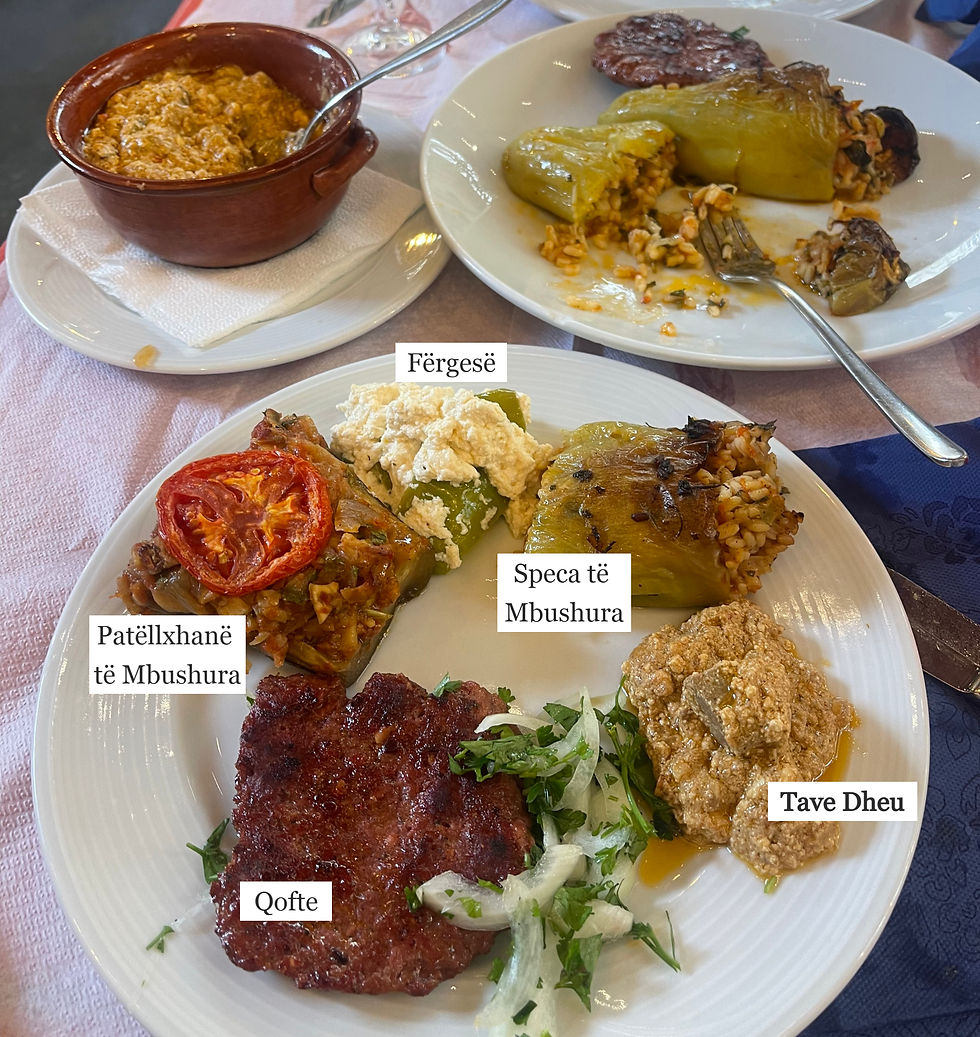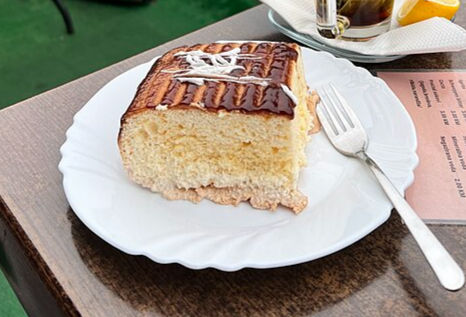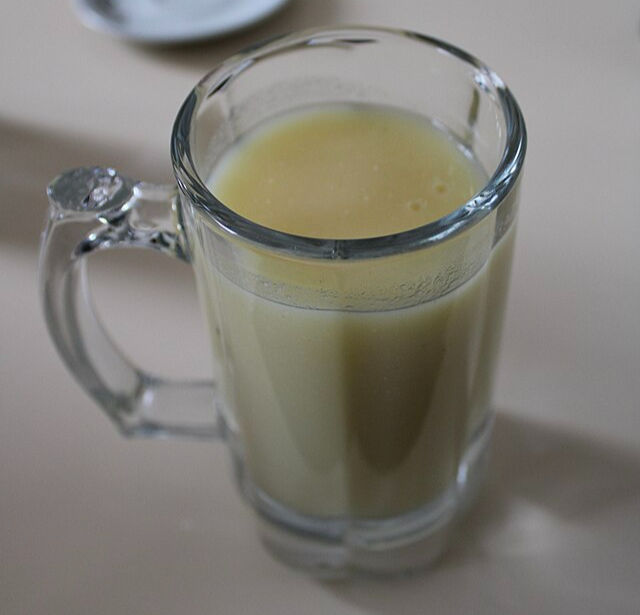Exploring Albanian Delights: A Culinary Journey through the Flavors of Albania
- Alanna Gabbett

- Mar 19
- 7 min read
Updated: Mar 27
Albania, a picturesque country located on the Adriatic and Ionian Seas, is rich in culture and history, and this is intricately woven into its culinary landscape. For food lovers, Albania offers a unique blend of Mediterranean and Balkan influences, creating an array of flavors that are both enticing and comforting. If you’re planning a trip to this beautiful country, your gastronomic adventure will be as memorable as the sights. Here’s a guide on what to eat and where to try it when you're in Albania.
Bookmark these reads for later:
To Rent or Not to Rent: Navigating Albania's Roads in a Rental Car
Discovering Albania's Most Significant Historical Sites: A Journey Through Time
When is the Best Time to Visit Albania? A Seasonal Guide for Travelers
How to Prepare for Your First International Adventure: Our Top Tips for New Explorers
Affordable Destinations for Budget Travelers: Exploring 5 Eastern European Locations
Mastering the Art of Budget Travel: A Complete Guide to Planning an Affordable Vacation
This blog may contain affiliate links. If you make a purchase through these links, I may receive a commission at no extra cost to you. I only share products and services that I personally trust and recommend. Thanks for supporting this site!
Albanian cuisine shares many similarities with Middle Eastern cuisine due to centuries of Ottoman rule, which heavily influenced the region’s food traditions. Many dishes, such as byrek (a flaky pastry similar to Turkish börek), baklava (a layered dessert with nuts and syrup), and qofte (spiced meatballs), have clear Middle Eastern roots. The use of spices like black pepper, oregano, and chili, as well as slow-cooked stews and grilled meats, is another common trait between the two culinary traditions.
Additionally, dishes like stuffed vegetables (Japrak and Speca të Mbushura), tavë kosi (baked lamb with yogurt, similar to some Turkish and Persian yogurt-based dishes), and raki (a strong distilled spirit, akin to Middle Eastern arak) highlight the shared food culture. Albanian cuisine, however, incorporates more Mediterranean elements, such as fresh herbs, olive oil, and dairy, giving it a unique balance between Middle Eastern depth and Balkan freshness.
While Albanian cuisine shares many similarities with Middle Eastern food, it also has distinct characteristics that set it apart. Unlike the heavily spiced and often complex flavor profiles of Middle Eastern dishes, Albanian food tends to be simpler and lighter, relying more on fresh herbs, dairy, and olive oil rather than intense spice blends. The strong Mediterranean influence means that seafood, fresh vegetables, and citrus flavors play a larger role, especially in coastal regions. Additionally, Albania’s use of Gjizë (a type of cottage cheese) and fermented dairy products like dhallë (similar to ayran but milder) gives its cuisine a unique touch. The presence of Italian influences, such as pasta and risotto, further distinguishes it from traditional Middle Eastern fare.
Traditional Albanian Dishes
Traditional Albanian cuisine is a delightful blend of Mediterranean, Balkan, and Ottoman influences, offering a rich variety of flavors and ingredients. From hearty stews and grilled meats to fresh vegetables and yogurt-based dishes, Albanian food emphasizes simple, fresh, and local ingredients. Albanian cuisine invites you to explore a world of vibrant tastes and time-honored recipes.
Byrek
Byrek is arguably one of the most beloved dishes in Albania. This savory pastry, filled with ingredients such as cheese, spinach, or minced meat, is a staple in Albanian households and can be found in street vendors and restaurants alike. It is often enjoyed with yogurt.
Two versions of Byrek
Tavë Kosi
The National Dish - Tavë Kosi is a must-try when in Albania. This is a baked dish made with lamb, rice, and a yogurt-based sauce. The dish is a perfect representation of the combination of flavors that define Albanian cuisine, melding savory meat with the tanginess of yogurt. It’s typically served hot and is ideal for a hearty lunch or dinner.
Tavë Dheu
This dish is very similar to Tavë Kosi, usually being baked in a clay pot and made of similar ingredients. However, this dish is made with diced liver, various cheeses, and bell pepper. Other ingredients may include tomatoes, garlic, onion, and spices such as chili powder or sumac.

Fërgesë
Fërgesë is a delicious meal that comes from the southern region of Albania. Made primarily from peppers, tomatoes, and cheese, it’s a vegetarian delight that can be enjoyed as a main course or side dish. This dish embodies the use of fresh vegetables typical of the Albanian diet. The smoky flavor of baked peppers combined with creamy cheese is simply unforgettable.
Speca të Mbushura
Stuffed bell peppers with rice and minced meat - a simple yet delicious dish that you can find in almost any traditional Albanian restaurant.
Patëllxhanë të Mbushura
Similar to Speca të Mbushura, Patëllxhanë të Mbushura is a traditional Albanian dish of eggplants stuffed with minced meat, onions, tomatoes, and spices, then baked until tender and flavorful. It’s a popular comfort food, often served with bread or rice.
Japrak
Japrak is a traditional Albanian dish consisting of grape leaves stuffed with rice, herbs, and sometimes minced meat, then slowly cooked until tender. It has Ottoman roots and is popular throughout Albania, often served with yogurt or a squeeze of lemon for extra flavor. You may be familiar with japrak if you've ever had sarma or dolma.

Regional Specialties
From the coastal influences of fresh seafood in seaside towns, to the hearty, rustic dishes of the northern mountains, each region of Albania offers its own distinct flavors and ingredients. Albania’s regions provide a culinary journey full of traditional recipes passed down through generations, many of which have striking similarities with minor differences in ingredients, spices, or preparation.
Pite
Pite is another popular pastry in Albania but differs from Byrek. While Byrek often has a flaky crust, Pite generally features thicker layers and can be filled with various ingredients including pumpkin, cheese, or nettles. Most commonly, pite can be found in the Northern regions of Albania, however, each region adds its unique twist to this dish, making it a fascinating option to explore.
Qofte
Hailing from the central and southern regions, qofte, or Albanian meatballs, are a traditional dish that can often be found in taverns across the country. Made from a mixture of minced meat (usually lamb or beef), herbs, and spices, these meatballs are fried until crispy on the outside and tender on the inside. They are typically served with a side of bread and yogurt sauce.
Speca me Gjize
This dish involves peppers stuffed with a creamy cheese mixture, offering a balance of textures and flavors. The peppers themselves may often by pickled or fermented as well. It’s often considered comfort food and is especially popular during the summer months when fresh produce is available. Whether enjoyed as an appetizer or a main course, Speca me Gjize is a delightful way to experience the local cuisine. This dish is particularly common in Southern regions, such as Vlora and Gjirokastër.

Desserts
Albanian desserts delightfully blend Mediterranean, Ottoman, and Balkan influences, offering a variety of sweet treats that showcase the country’s love for rich flavors and simple ingredients. Albanian sweets often feature ingredients like honey, nuts, and yogurt, combining sweetness with a touch of tang, creating a balance that complements the country's savory cuisine.
Baklava
No visit to Albania is complete without sampling Baklava. This rich, sweet dessert is layered with nuts (usually pistachios or walnuts) and honey or simple syrup, creating an indulgent treat that's sure to satisfy any sweet tooth. It’s a perfect ending to an Albanian meal and can be found in cafes and bakeries all over the country.
Different versions of baklava.
Kadaif
Kadaif is another popular dessert made with shredded phyllo dough, usually rolled and filled with nuts, and soaked in syrup. It's lighter than Baklava but no less delicious, making it a great option for those wanting to try various sweets.
Petulla
Petulla are fried doughnuts, often served warm and dusted with powdered sugar or honey. They are especially popular during festive events or special gatherings. Trying them freshly made from a local vendor is an experience you won’t want to miss.
Revani
A popular dessert in Albanian cuisine, Revani is known for its light texture and sweet, fragrant taste. It's a moist, semolina-based cake soaked in sweet syrup, often flavored with lemon or orange zest.
Shëndetlie
A traditional Albanian honey and walnut cake, known for its dense texture and rich flavor. It is often enjoyed during special occasions and is prized for its sweetness and the healthful qualities of its natural ingredients.
Trilece
Trilece is a popular Albanian dessert made from a soft sponge cake soaked in three types of milk—evaporated, condensed, and whole milk—creating a rich, creamy texture. Often topped with whipped cream or caramel, it’s a sweet and indulgent treat enjoyed across the Balkans.

Drinks
Traditional drinks in Albanian, both alcoholic and non-alcoholic are deeply rooted in the country’s Mediterranean and Ottoman heritage. These drinks reflect Albania’s diverse history, blending Mediterranean, Balkan, and Ottoman influences, which prioritize fresh, local ingredients and simple yet flavorful preparations.
Raki
A strong traditional Albanian spirit, usually distilled from grapes or plums, and is often enjoyed as an aperitif or with meals. It holds cultural significance in Albania, commonly shared among family and friends, especially during gatherings and celebrations. This drink can be found in many countries across the Mediterranean and Balkan region.
Boza
Boza is a traditional Albanian fermented drink made from corn or wheat, known for its thick, slightly sweet, and tangy flavor. It is especially popular in colder months and is enjoyed as a nostalgic, energy-boosting beverage.

Dhallë
Dhallë is a refreshing, yogurt-based drink popular in Albanian cuisine, similar to ayran. It is made by mixing yogurt, water, and a pinch of salt, offering a cooling and savory accompaniment to many traditional dishes.
Albanian cuisine offers an exciting variety of flavors and dishes that reflect the cultural richness of this beautiful country. From hearty meat dishes to exquisite pastries, the food is a mirror of the land’s heritage and traditions. As you embark on your culinary journey through Albania, be sure to visit local eateries, explore regional specialties, and indulge in desserts that will leave you with sweet memories long after your trip.
Whether you are enjoying Byrek on the bustling streets of Tirana, savoring Tavë Kosi in the charming town of Berat, or relishing Baklava in a seaside café, the flavors of Albania are sure to entice and welcome you into the heart of its culinary world. Happy eating!












Comments